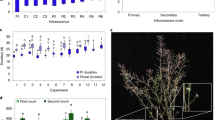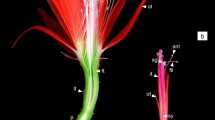Abstract
In this study we investigatedArabidopsis thaliana (L.) Heynh. inflorescence development by characterizing morphological changes at the shoot apex during the transition to flowering. Sixteen-hour photoperiods were used to synchronously induce flowering in vegetative plants grown for 30 d in non-inductive 8-h photoperiods. During the first inductive cycle, the shoot apical meristem ceased producing leaf primordia and began to produce flower primordia. The differentiation of paraclades (axillary flowering shoots), however, did not occur until after the initiation of multiple flower primordia from the shoot apical meristem. Paraclades were produced by the basipetal activation of buds from the axils of leaf primordia which had been initiated prior to photoperiodic induction. Concurrent with the activation of paraclades was the partial suppression of paraclade-associated leaf primordia, which became bract leaves. The suppression of bract-leaf primordia and the abrupt initiation of flower primordia during the first inductive photoperiod is indicative of a single phase change during the transition to flowering in photoperiodically inducedArabidopsis. Morphogenetic changes characteristic of the transition to flowering in plants grown continuously in 16-h photoperiods were qualitatively equivalent to the changes observed in plants which were photoperiodically induced after 30 d. These results suggest thatArabidopsis has only two phases of development, a vegetative phase and a reproductive phase; and that the production of flower primordia, the differentiation of paraclades from the axils of pre-existing leaf primordia and the elongation of internodes all occur during the reproductive phase.
Similar content being viewed by others
Abbreviations
- LFY :
-
theArabidopsis gene,LEAFY
- lfy :
-
theleafy phenotype ofArabidopsis
- EM F :
-
theArabidopsis gene,EMBRYONIC FLOWER
References
Araki, T., Komeda, Y. (1993) Analysis of the role of the late-flowering locus,GI, in the flowering ofArabidopsis thaliana. Plant J.3, 231–239
Bernier, G. (1962) Evolution of the apical meristem ofSinapis alba L.(long-day plant) in long days, in short days and during the transition from short to long days. Caryologia15, 303–325
Bernier, G. (1986) The flowering process as an example of plastic development. In: Plasticity in plants, pp. 257–286, Jennings, D.H., Trewavas, A.J. eds. Society for Experimental Biology/Company of Biologists, Ltd., Cambridge, Great Britain
Bernier, G., Kinet, J., Sachs, R.M. (1981) The physiology of flowering. Volume II: Transition to reproductive growth. CRC Press, Boca Raton, Florida
Coen, E.S., Meyerowitz, E.M. (1991) The war of the whorls: genetic interactions controlling flower development. Nature353, 31–37
Dennin, K., McDaniel, C.N. (1985) Floral determination in axillary buds ofNicotiana sylvestris. Dev. Biol.112, 377–382
Evans, L.T. (1969) The nature of flower induction. In: The induction of flowering: some case histories, pp. 457–480, Evans, L.T. ed. MacMillan, New York
Gifford, E.M., Jr. (1954) The shoot apex in angiosperms. Bot. Rev.20, 477–529
Huala, E., Sussex I.M. (1992)LEAFY interacts with floral homeotic genes to regulateArabidopsis floral development. Plant Cell4, 901–913
Koornneef, M., Hanhart, C.J., van der Veen, J.H. (1991) A genetic and physiological analysis of late flowering mutants inArabidopsis thaliana. Mol. Gen. Genet.229, 57–66
Lechner, F.J., Rau, W. (1993) A complex pattern of changes in polysomal messenger RNA populations is evident in the leaves ofArabidopsis thaliana L. Heynh. during photoperiodic induction of flowering. Planta189, 522–532
Lee, I., Bleecker, A., Amasino, R. (1993) Analysis of naturally occurring late flowering inArabidopsis thaliana. Mol. Gen. Genet.237, 171–176
Mandel, M.A., Gustafson-Brown, C., Savidge, B., Yanofsky, M.F. (1992) Molecular characterization of theArabidopsis floral homeotic geneAPETALA 1. Nature360, 273–277
McDaniel, C.N., Singer, S.R., Smith, S.M.E. (1992) Developmental states associated with the floral transition. Dev. Biol.153, 59–69
Medford, J.I. (1992) Vegetative apical meristems. Plant Cell4, 1029–1039
Melzer, S., Majewski, D.M., Apel, K. (1990) Early changes in gene expression during the transition from vegetative to generative growth in the long-day plantSinapis alba. Plant Cell2, 953–961
Miksche, J.P., Brown, J.A.M. (1965) Development of vegetative and floral meristemsof Arabidopsis thaliana. Am. J. Bot.52, 533–537
Napp-Zinn, K. (1985)Arabidopsis thaliana. In: CRC handbook of flowering, vol I., pp. 492–503, Halevy, H.A. ed. CRC Press, Boca Raton, Florida
Ormrod, J.C., Bernier, G. (1990) Cell cycle patterns in the shoot apex ofLolium temulentum L.cv. Ceres during the transition to flowering following a single long day. J. Expt. Bot.41, 211–216
Orr, A.R. (1978) Inflorescence development inBrassica campestris L. Am. J. Bot.65, 466–470
Schultz, E.A., Haughn, G.W. (1991)LEAFY, a homeotic gene that regulates inflorescence development inArabidopsis. Plant Cell3, 771–781
Sell, Y. (1980) Physiological and phylogenetic significance of the direction of flowering in inflorescence complexes. Flora169, 282–294
Shannon, S., Meeks-Wagner, D.R. (1991) A mutation in theArabidopsis TFL 1 gene affects inflorescence meristem development. Plant Cell3, 877–892
Shannon, S., Meeks-Wagner, D.R. (1993) Genetic interactions that regulate inflorescence development inArabidopsis. Plant Cell5, 639–655
Singer, S.R., McDaniel, C.N. (1986) Floral determination in the terminal and axillary buds ofNicotiana tabacum L. Dev. Biol.118, 587–592
Sung, Z.R., Belachew, A., Shunong, B., Bertrand-Garcia, R. (1992) EMF, anArabidopsis gene required for vegetative shoot development. Science258, 1645–1647
Thomas, J.F., Anderson, C.E., Raper, C.D., Jr., Downs, R.J. (1975) Time of floral initiation in tobacco as a function of temperature and photoperiod. Can. J. Bot.53, 1400–1410
Vaughan, J.G. (1955) The morphology and growth of the vegetative and reproductive apices ofArabidopsis thaliana (L.) Heynh.,Capsella bursa-pastoris (L.) Medic.andAnagallis arvensis L. J. Linn. Soc. London Bot.55, 279–300
Vince-Prue, D. (1975) Photoperiodism in plants, McGraw Hill, London
Weberling, F. (1989) Morphology of flowers and inflorescences, Cambridge University Press, Cambridge, Great Britain
Weigel, D., Meyerowitz, E.M. (1993) Genetic hierarchy controlling flower development. In: Molecular basis of morphogenesis, pp. 91–105, Bernfield, M., ed. 51st Ann. Symp. Soc. Dev. Biol., Wiley & Sons, New York
Weigel, D., Alvarez, J., Smyth, D.R., Yanofsky, M.F., Meyerowitz, E.M. (1992)LEAF Y controls floral meristem identity inArabidopsis. Cell69, 843–859
Wetmore, R.H., Gifford, E.M., Jr., Green, C.H. (1959) Development of vegetative and floral buds. In: Photoperiodism and related phenomena in plants and animals, pp. 255–273, Withrow, R.B., ed. AAAS Publication #255, Washington D.C.
Zagotta, M.T., Shannon, S., Jacobs, C., Meeks-Wagner, D.R. (1992) Early-flowering mutants ofArabidopsis thaliana. Aust. J. Plant Physiol.19, 411–418
Author information
Authors and Affiliations
Additional information
We thank Allen Sessions, Michael Christianson, Lisa Parker, Daxius Gregory and two anonymous reviewers for comments on the manuscript; Ian Sussex, Alemu Belachew, Nancy Kerk, Detlef Weigel, Stacy Steinberg, Sheila McCormick, Eva Huala, Steve Ruzin, Zac Cande and Don Kaplan for insight and discussion during the preparation of the manuscript; Detlef Weigel for access to an unpublished manuscript; Don Pardoe and the UC Berkeley Electron Microscopy Lab for training and technical support; Steve Ruzin and the NSF Center of Plant Developmental Biology for equipment loans and technical assistance. This work was supported by U.S. Department of Agriculture grant # 93-37304-9141 to L.J.F.
Rights and permissions
About this article
Cite this article
Hempel, F.D., Feldman, L.J. Bi-directional inflorescence development inArabidopsis thaliana: Acropetal initiation of flowers and basipetal initiation of paraclades. Planta 192, 276–286 (1994). https://doi.org/10.1007/BF01089045
Received:
Accepted:
Issue Date:
DOI: https://doi.org/10.1007/BF01089045




